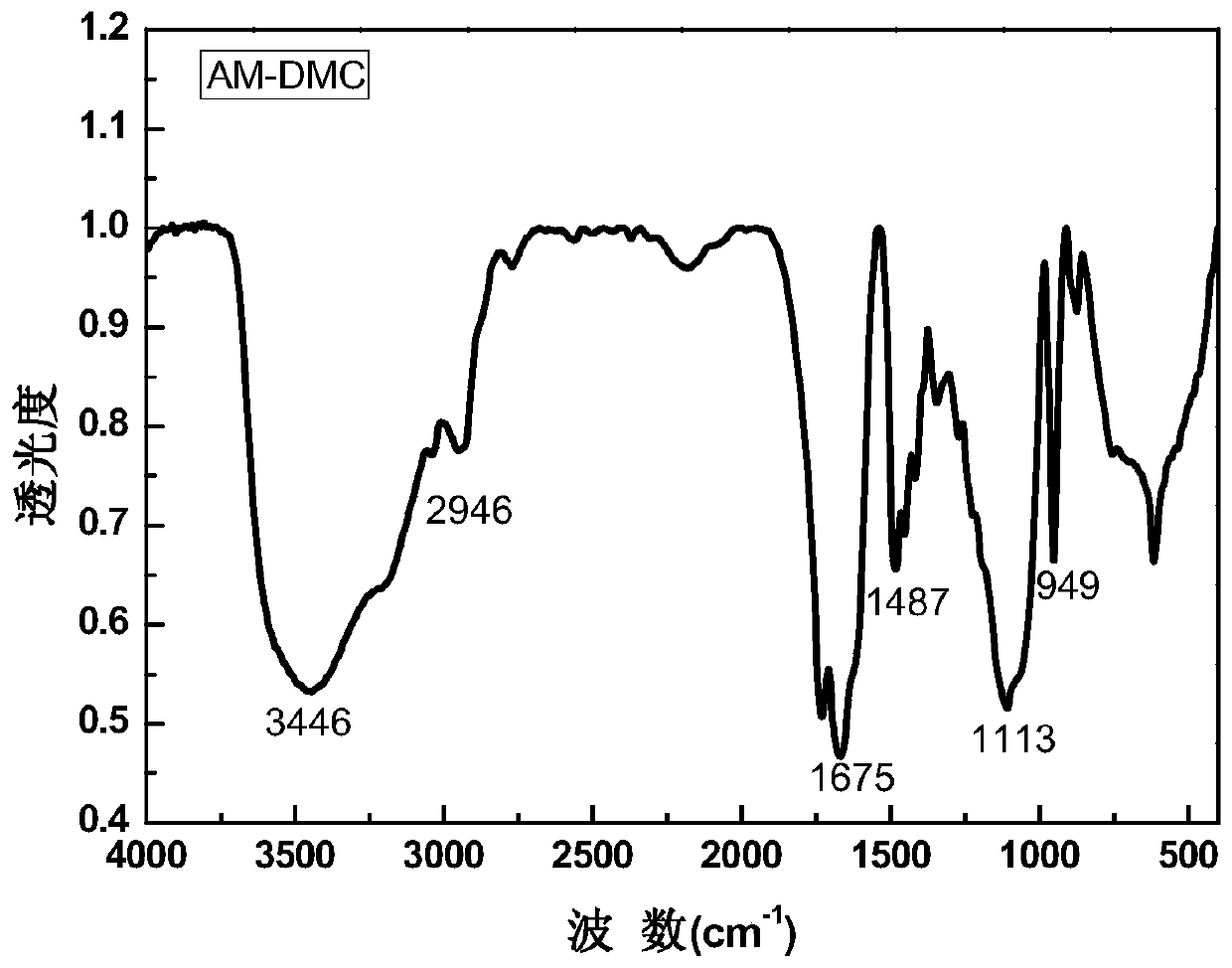A method for preparing cationic polyacrylamide emulsion by water dispersion polymerization
A technology of polyacrylamide and dispersion polymerization, applied in chemical instruments and methods, water pollutants, water/sewage treatment, etc., can solve the problems of reduced particle swelling, complex demulsification process, high production cost, etc., and achieve good stability Sexuality and fluidity, avoid mutual aggregation, fast dissolution effect
- Summary
- Abstract
- Description
- Claims
- Application Information
AI Technical Summary
Problems solved by technology
Method used
Image
Examples
Embodiment 1
[0050] Acrylamide 11.88g, methacryloyloxyethyltrimethylammonium chloride (80wt%) 7.85g, polymethacryloyloxyethyltrimethylammonium chloride aqueous solution (16wt%, molecular weight 1.09×10 6 g / mol) 16.875g, ammonium sulfate 35.2g, edetate disodium 0.025g, and deionized water 44.37g were mixed and stirred to form a homogeneous solution, and poured into a container equipped with a mechanical stirrer, a condenser tube, a thermometer and a nitrogen conduit. In a 250ml four-necked flask, stir at a constant speed of 350rpm in a constant temperature water bath at 56°C, and pass nitrogen gas for 30min, then inject 0.7ml of 0.5wt% graphene oxide aqueous solution (when preparing 0.5wt% graphene oxide aqueous solution, Ultrasonic dispersion for 30 minutes to make graphene oxide dissolve uniformly in the aqueous solution) and 1.4ml of 0.5wt% ammonium persulfate aqueous solution were injected into the reaction system, and the reaction continued until the system became viscous, and after 3.5...
Embodiment 2
[0053] Acrylamide 11.88g, acryloyloxyethyltrimethylammonium chloride (80wt%) 7.85g, polyacryloyloxyethyltrimethylammonium chloride aqueous solution (16wt%, molecular weight 1.39×10 6 g / mol) 18.00g, ammonium sulfate 37.2g, disodium edetate 0.025g, and deionized water 45.045g were mixed and stirred to form a homogeneous solution, and poured into a container equipped with a mechanical stirrer, a condensation tube, a thermometer and a nitrogen conduit. In a 250ml four-neck flask, stir at a constant speed of 400rpm in a constant temperature water bath at 56°C, and pass nitrogen gas for 30min, then inject 0.7ml of 0.5wt% graphene oxide aqueous solution and 1.4ml of 0.5wt% ammonium persulfate aqueous solution into In the reaction system, continue the reaction until the system becomes viscous. After 4 hours, add 0.3ml of 0.5wt% graphene oxide aqueous solution and 0.6ml of 0.5wt% ammonium persulfate aqueous solution. After 12 hours of reaction, add the remaining 2.0g of ammonium sulfate...
Embodiment 3
[0055] Acrylamide 11.88g, methacryloyloxyethyltrimethylammonium chloride (80wt%) 3.93g, acryloyloxyethyltrimethylammonium chloride (80wt%) 3.93g, polymethacryloyloxy Ethyltrimethylammonium chloride aqueous solution (16wt%, molecular weight 1.61 * 106g / mol) 18.00g, ammonium sulfate 37.2g, edetate disodium 0.025g, deionized water 45.045g are mixed and stirred to form a homogeneous solution, Pour it into a 250ml four-neck flask equipped with a mechanical stirrer, a condenser, a thermometer and a nitrogen conduit, stir at a constant speed at a stirring rate of 350rpm in a constant temperature water bath at 50°C, and pass nitrogen for 30min, then use a syringe to inject 0.7ml of 0.5wt% Graphene oxide aqueous solution and 2.1ml of 0.5wt% ammonium persulfate aqueous solution were injected into the reaction system, and the reaction was continued until the system became viscous. After 3 hours, 0.3ml of 0.5wt% graphene oxide aqueous solution and 0.9ml of 0.5wt% Ammonium persulfate aqueo...
PUM
 Login to View More
Login to View More Abstract
Description
Claims
Application Information
 Login to View More
Login to View More - R&D
- Intellectual Property
- Life Sciences
- Materials
- Tech Scout
- Unparalleled Data Quality
- Higher Quality Content
- 60% Fewer Hallucinations
Browse by: Latest US Patents, China's latest patents, Technical Efficacy Thesaurus, Application Domain, Technology Topic, Popular Technical Reports.
© 2025 PatSnap. All rights reserved.Legal|Privacy policy|Modern Slavery Act Transparency Statement|Sitemap|About US| Contact US: help@patsnap.com



